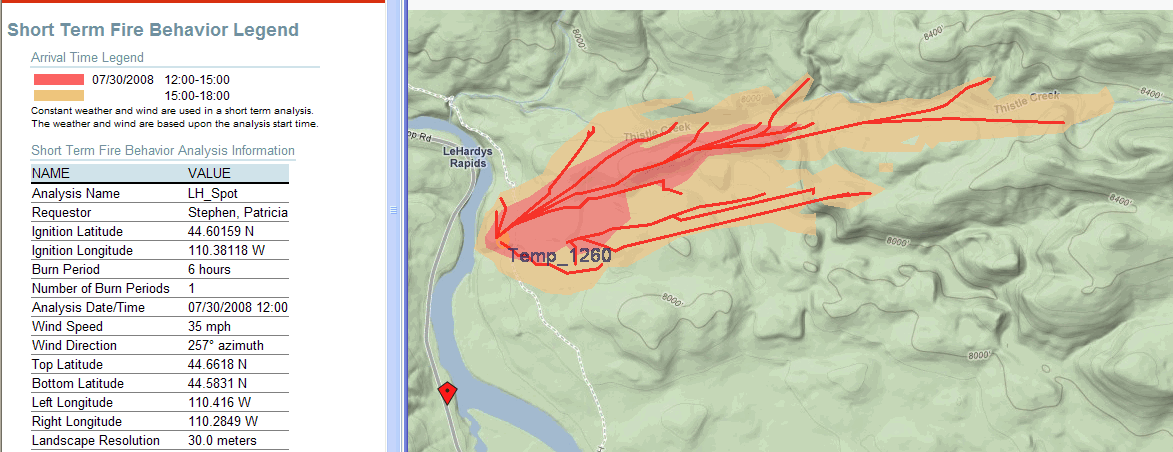WFDSS STFB - What it means (interpretation)
WFDSS Short-Term Fire Behavior (STFB) output results are fairly straightforward to interpret. The following image shows an Automated STFB analysis with both Arrival Time and Major Paths displayed. The legend provides the inputs used for the analysis and describes the hours used for the Arrival Time output. In this example, the legend displays the date and hours for the Arrival Time, as well as the Short-Term Fire Behavior Analysis Information. The dark red lines depict the simulated fire's Major Paths.

Automated STFB Outputs with Legend
Although initial fuel moistures are conditioned prior to ignition and gridded winds are generated from the inputs, the outputs still represent just a single 'snapshot in time'. Weather conditions (wind, temperature, humidity, precipitation, etc.) do not change throughout the scenario and, although the fuels are conditioned to the start time, fuel moistures do not change over the course of the analysis, either.
The MTT flow path results of an Automated STFB run represent only the influence of topography combined with the static (but gridded) wind speed and direction used in the inputs. If the influence of changing weather conditions over time is important for answering the question being asked, then consider locating an analyst to complete an Near Term Fire Behavior (NTFB) run.
When interpreting these output results it is crucial to remember the numerous WFDSS Automated STFB Assumptions and Limitations.
- WFDSS Automated Short-Term Fire Behavior (STFB) calculates fire behavior outputs using fuel moistures based on topographic information, forest canopy cover, and the previous seven days of weather data (for fuel moisture conditioning) from the WFDSS-selected RAWS. However, the RAWS selected by WFDSS cannot be changed by the user. In addition, the RAWS data cannot be edited by the user.
- The 20' wind speed and direction (from historic observations, NDFD or supplied by the user) are used as inputs into WindNinja to create gridded 20' winds at 200-meter resolution. The input winds are considered to be an average across the entire landscape and will be stronger at the ridgetops and lighter in valley bottoms. The resulting gridded values are used as the STFB Wind Speed and Wind Direction inputs to calculate fire behavior for each pixel.
- Though forward fire spread over time is displayed, the weather conditions (except gridded winds) do not change throughout the duration of the analysis. Outputs are weather dependent more than time dependent. Though hours are displayed in the outputs, they should be interpreted to match weather conditions and not clock hours. "Under these static conditions, the fire could move this far in six hours", not "the fire will reach this road at 1900 hours".
- Fuel moisture values (as calculated at the analysis start date and time) are held constant for the duration of the STFB simulation.
- WFDSS STFB uses most of the same underlying fire models (Rothermel's 1972 surface fire model, Van Wagner's 1977 crown fire initiation model, Rothermel's 1991 crown fire spread model, Albini's 1979 spotting from torching trees, and Nelson's 2000 dead fuel moisture model) used in other fire behavior applications; thus, the assumptions and limitations of those underlying fire models are inherent within WFDSS STFB.
- Fire growth calculations for STFB across the landscape extent are performed assuming independence of fire behavior between neighboring cells. In other words, the travel time across a cell does not depend on the behavior in adjacent cells.
- This automated version of STFB only allows for a single-point ignition (1/10th acre fires).
- As with all models, the quality of the outputs from WFDSS Automated STFB depends on the quality of the inputs used. If the landscape data or RAWS data used are inadequate, the resulting fire behavior outputs will be questionable. It is important to be familiar with and assess the fuels data, as well as the RAWS data before using WFDSS Automated STFB in support of wildland fire decision-making. If the input data is suspect, then consider the output results suspect as well.
- The output results from an Automated STFB analysis cannot be saved or downloaded for use in a GIS, they can only be displayed within WFDSS. In addition, after 20 days the analysis is automatically deleted by WFDSS.
In This Section |
See Also |
Reference |